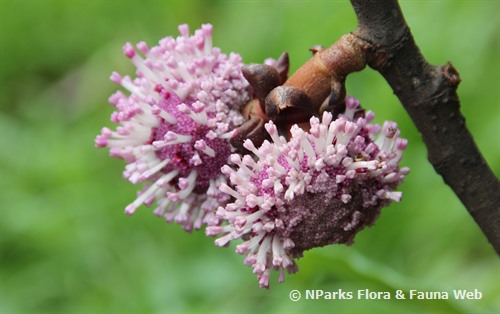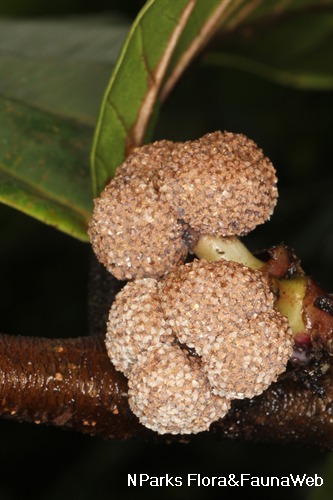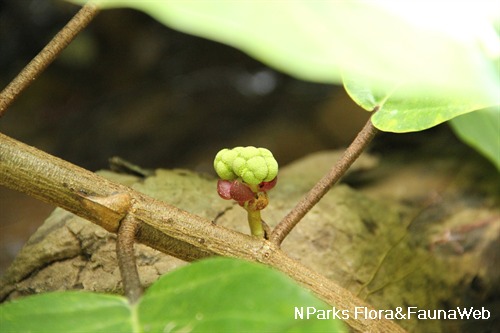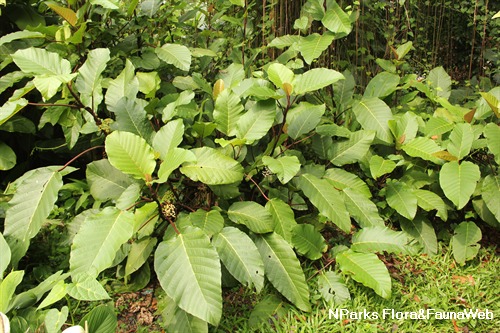
Back
Poikilospermum suaveolens (Blume) Merr.
| Family Name: | Urticaceae |
| Common Name: | Akar Murah, Akar Setawan, Ara Jankang, Centawan, Mentawan, Tentawan, 锥头麻 |
Name
Classifications and Characteristics
| Plant Division | Angiosperms (Flowering Seed Plants) (Dicotyledon) |
|---|---|
| Plant Growth Form | Climber |
| Lifespan (in Singapore) | Perennial |
| Mode of Nutrition | Autotrophic |
| Plant Shape | Irregular |
Biogeography
| Native Distribution | India, southeast China, Myanmar, Vietnam, Laos, Cambodia, the Philippines, south Thailand, the Nicobar Islands, Sumatra, Peninsular Malaysia, Singapore, Borneo, Java, Sulawesi, and the Moluccas |
|---|---|
| Native Habitat | Terrestrial (Primary Rainforest, Secondary Rainforest, Freshwater Swamp Forest, Riverine) |
| Preferred Climate Zone | Tropical, Sub-Tropical / Monsoonal |
| Local Conservation Status | Native to Singapore (Vulnerable (VU)) |
Description and Ethnobotany
| Growth Form | It is a large epiphytic climber. |
|---|---|
| Foliage | Its alternate, stalked leaves have leaf blades that are broadly egg-shaped-oblong, and 10-60 by 2-25 cm, with purplish veins beneath. |
| Flowers | Its flowers are pink or yellow and tiny, with male flowers 1.5-2 mm long, and female flowers up to 10 mm long, The flowers are borne on branched head-like clusters, with the male clusters 2 - 5 cm wide, and female clusters 6 - 9 cm wide. |
| Fruit | Its fruits are oblong-obovoid, warty achenes, 3-5 mm. |
| Habitat | It is found in rainforest, often growing on rocks along rivers and streams, up to 700 m altitude. |
| Associated Fauna | Its flowers are visited by ants, small stingless bees, the olive-backed sunbird, and the plain sunbird. |
| Cultivation | It can be propagated from seed or stem cuttings. |
| Ethnobotanical Uses | Medicinal: The juice of pounded leaves or leaf decoctions was used for treating fevers and kidney ailments. The leaves and roots are used to poultice fever and itch. Aerial roots are smoked to treat nose ulcers or as a stimulant. The aerial roots and stem when cut, provide drinking water. The juice of the stem can also be used for treating eyesores. Others: The fibre-rich bark is used to make rope. |
Landscaping Features
| Landscaping | It is suitable for parks and gardens by pruning it to take on the habit of a shrub. |
|---|---|
| Desirable Plant Features | Ornamental Foliage |
| Landscape Uses | General, Parks & Gardens, Small Gardens |
Fauna, Pollination and Dispersal
| Fauna Pollination Dispersal Associated Fauna | Bird-Attracting (Flowers), Butterfly Host Plant (Leaves) |
|---|---|
| Pollination Method(s) | Biotic (Fauna) (Insects (Bee), Insects (Ant, Beetle, Fly, Thrip, Wasp)) |
| Seed or Spore Dispersal | Abiotic |
Plant Care and Propagation
| Light Preference | Full Sun, Semi-Shade |
|---|---|
| Water Preference | Moderate Water |
| Plant Growth Rate | Moderate |
| Rootzone Tolerance | Moist Soils, Well-Drained Soils, Fertile Loamy Soils, Easy to Grow |
| Maintenance Requirements | Moderate |
| Propagation Method | Seed, Stem Cutting |
Foliar
| Foliage Retention | Evergreen |
|---|---|
| Mature Foliage Colour(s) | Green |
| Mature Foliage Texture(s) | Leathery |
| Prominent Young Flush Colour(s) | Brown, Orange |
| Foliar Type | Simple / Unifoliate |
| Foliar Arrangement Along Stem | Alternate, Rosulate / Rosette |
| Foliar Attachment to Stem | Petiolate |
| Foliar Shape(s) | Non-Palm Foliage (Elliptical, Oblong) |
| Foliar Venation | Pinnate / Net |
Floral (Angiosperm)
| Flower & Plant Sexuality | Unisexual Flowers , Dioecious |
| Flower Colour(s) | Pink |
|---|
| Flower Grouping | Cluster / Inflorescence |
| Flower Location | Axillary |
| Inflorescence Type | Head / Capitulum |
Fruit, Seed and Spore
| Fruit Classification | Simple Fruit |
|---|---|
| Fruit Type | Indehiscent Dry Fruit , Achene |
Image Repository
Others
| Master ID | 31669 |
|---|---|
| Species ID | 6068 |
| Flora Disclaimer | The information in this website has been compiled from reliable sources, such as reference works on medicinal plants. It is not a substitute for medical advice or treatment and NParks does not purport to provide any medical advice. Readers should always consult his/her physician before using or consuming a plant for medicinal purposes. |






